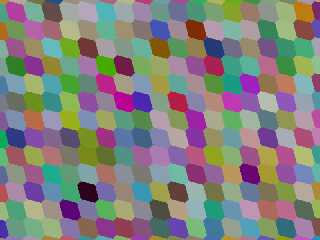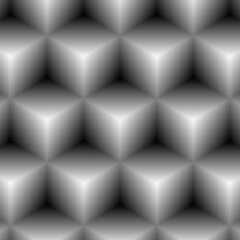 |
 |
|
 |
|
 |
|  |
|  |
|
 |
|
 |
|  |
|  |
|
 |
jr recently spammed me with a very interesting article, see:
https://www.quantamagazine.org/mathematicians-complete-quest-to-build-spherical-cubes-20230210
Therein, the authors reference J. Choe's tiling of a 2D plane with a hexagon
with minimal perimeter.
The original paper has a diagram with angles,
http://newton.kias.re.kr/~choe/fundamental.pdf
and another paper has the lengths of the sides.
https://www.researchgate.net/publication/267246574_Spherical_Cubes_Optimal_Foams_from_Computational_Hardness_Amplificat
ion
From that data, I was able to do a few rotations and use symmetry to getthe rest
of the points, and make a prism, which tiles the plane very nicely.
Next task is going to figure out how to make this into a pigment {function{}}
pattern, and color it like the inbuilt hexagon pattern.
Post a reply to this message
Attachments:
Download 'choehexagon.png' (90 KB)
Preview of image 'choehexagon.png'

|
 |
|  |
|  |
|
 |
|
 |
|  |
|  |
|
 |
Closely related to this,
during my search for more information on the Choe hexagonal tiling, I found the
attached image, which I think would make for an excellent heightfield.
Also, these tilings in 2D and 3D space are relaxed Voronoi foams.
Perhaps this adds fuel to the Voronoi variations.
And of course, since there is a 3D space partitioning in the 2nd paper, it would
be very interesting indeed to see what sort of surface pattern would result if
that were implemented in POV-Ray.
Post a reply to this message
|
 |
|  |
|  |
|
 |
|
 |
|  |
|  |
|
 |
Hi,
> And of course, since there is a 3D space partitioning in the 2nd paper, it would
> be very interesting indeed to see what sort of surface pattern would result if
> that were implemented in POV-Ray.
Really, tiling is very attractive. Surprisingly, few days ago I discovered this
collection of tiling ideas:
http://paulbourke.net/geometry/tilingplane/
Almost absolutely sure that you are familiar with it ....
--
YB
Post a reply to this message
|
 |
|  |
|  |
|
 |
|
 |
|  |
|  |
|
 |
"Bald Eagle" <cre### [at] netscape net> wrote:
> during my search for more information on the Choe hexagonal tiling, I found the
> attached image, which I
.... never attached. net> wrote:
> during my search for more information on the Choe hexagonal tiling, I found the
> attached image, which I
.... never attached.
Post a reply to this message
Attachments:
Download '5445.jpg' (64 KB)
Preview of image '5445.jpg'

|
 |
|  |
|  |
|
 |
|
 |
|  |
|  |
|
 |
"Bald Eagle" <cre### [at] netscape net> wrote:
> jr recently spammed me with a very interesting article, see:
> Next task is going to figure out how to make this into a pigment {function{}}
> pattern, and color it like the inbuilt hexagon pattern.
Although I have a decent scene that uses Martijn Steinrucker's hexagon pattern,
I tried to implement the hexagon patterns from POV-Ray's source code.
I got Jerome Grimbert's hexagonal tiling version to _almost_ work, and failed
miserably with the "simple" hexagon pattern - probably due to the complex
coloring code which uses some nested #switch blocks. Challenging stuff to
convert to functions.
Anyway, here's the simple scene code making a prism.
Maybe if anyone has experience making some of these pattern types, they could
post some tutorial material to explain the reasoning behind some of the
functions. net> wrote:
> jr recently spammed me with a very interesting article, see:
> Next task is going to figure out how to make this into a pigment {function{}}
> pattern, and color it like the inbuilt hexagon pattern.
Although I have a decent scene that uses Martijn Steinrucker's hexagon pattern,
I tried to implement the hexagon patterns from POV-Ray's source code.
I got Jerome Grimbert's hexagonal tiling version to _almost_ work, and failed
miserably with the "simple" hexagon pattern - probably due to the complex
coloring code which uses some nested #switch blocks. Challenging stuff to
convert to functions.
Anyway, here's the simple scene code making a prism.
Maybe if anyone has experience making some of these pattern types, they could
post some tutorial material to explain the reasoning behind some of the
functions.
Post a reply to this message
Attachments:
Download 'choehexagon.pov.txt' (4 KB)
|
 |
|  |
|  |
|
 |
|
 |
|  |




![]()